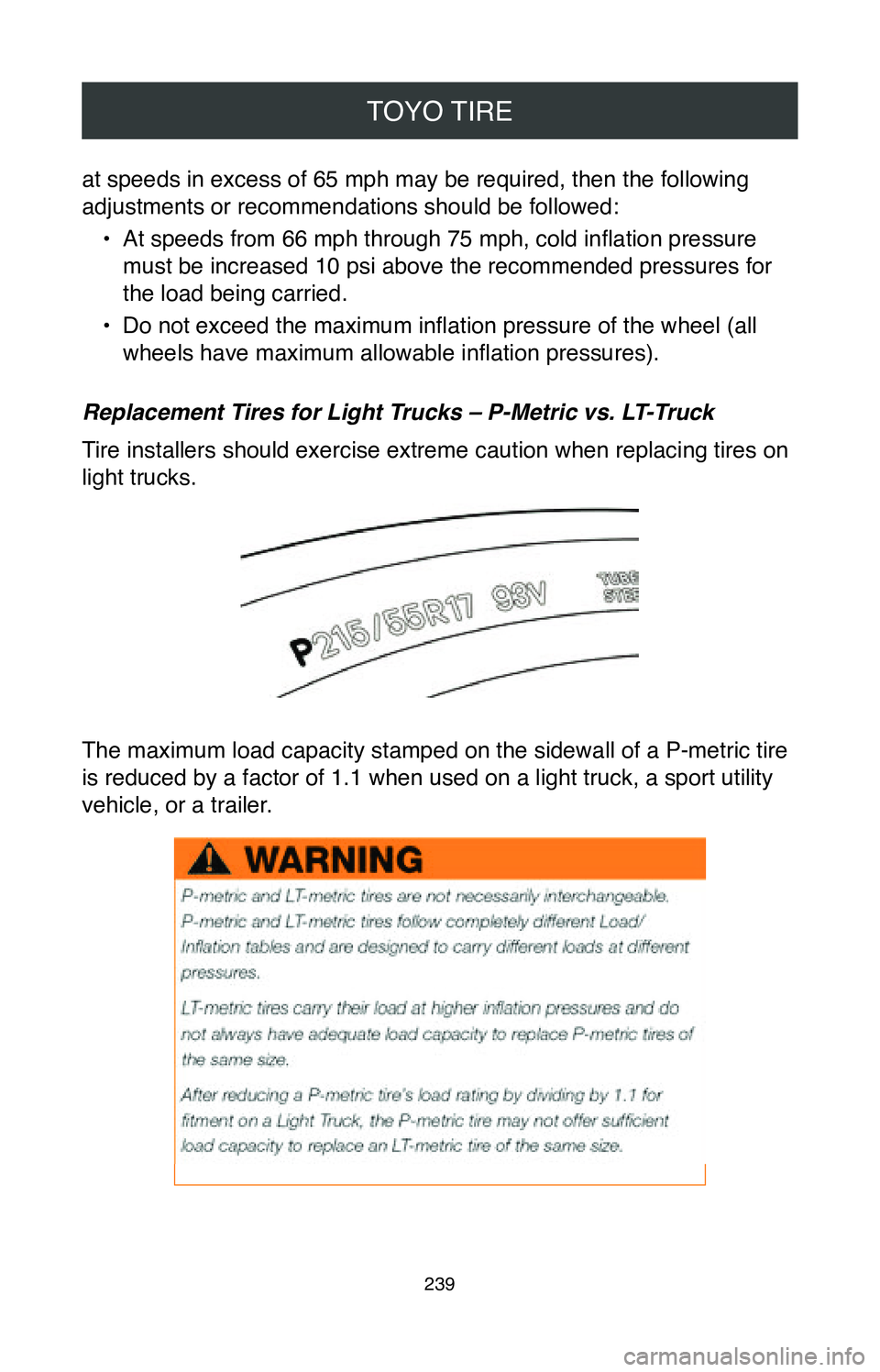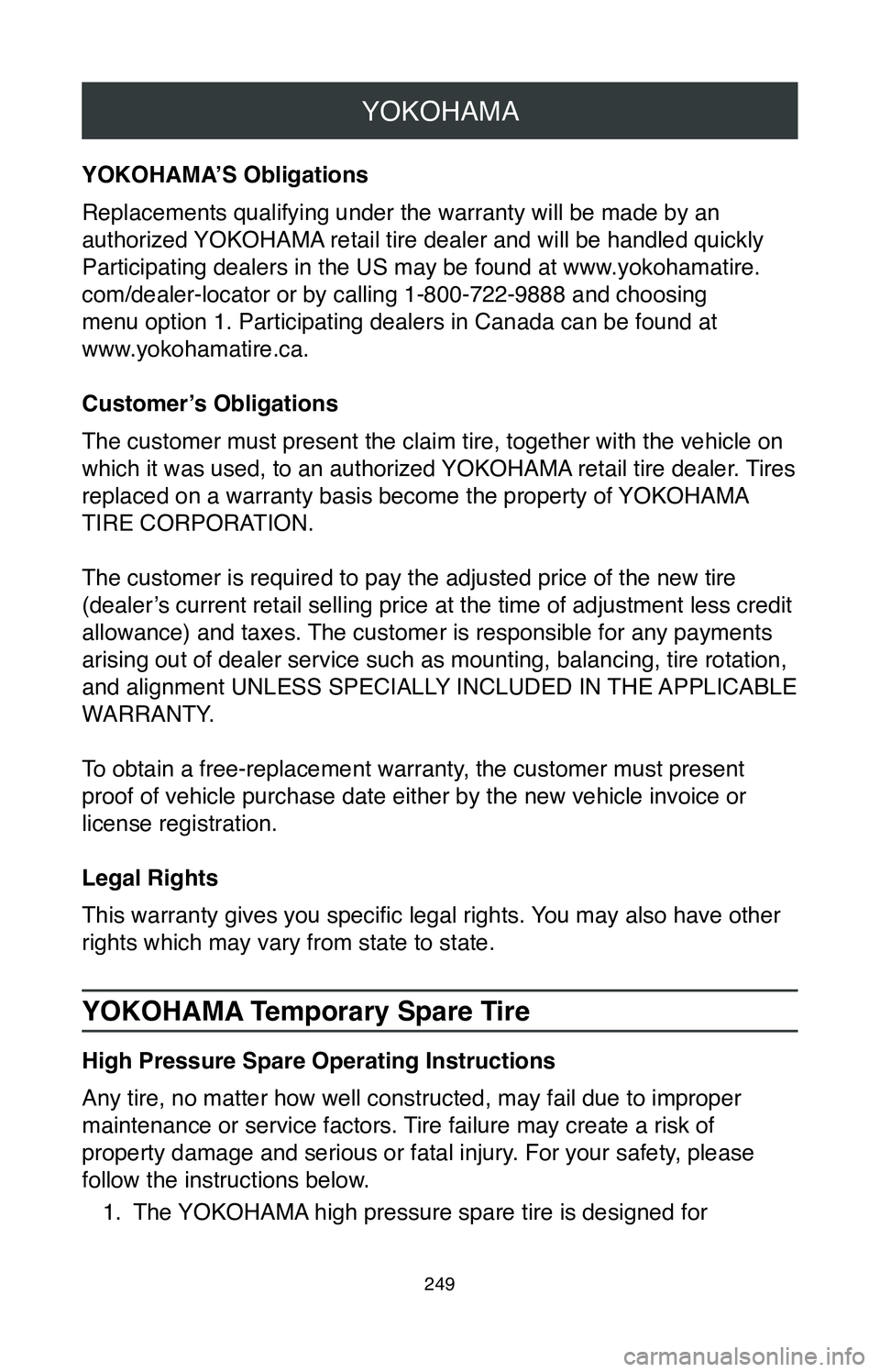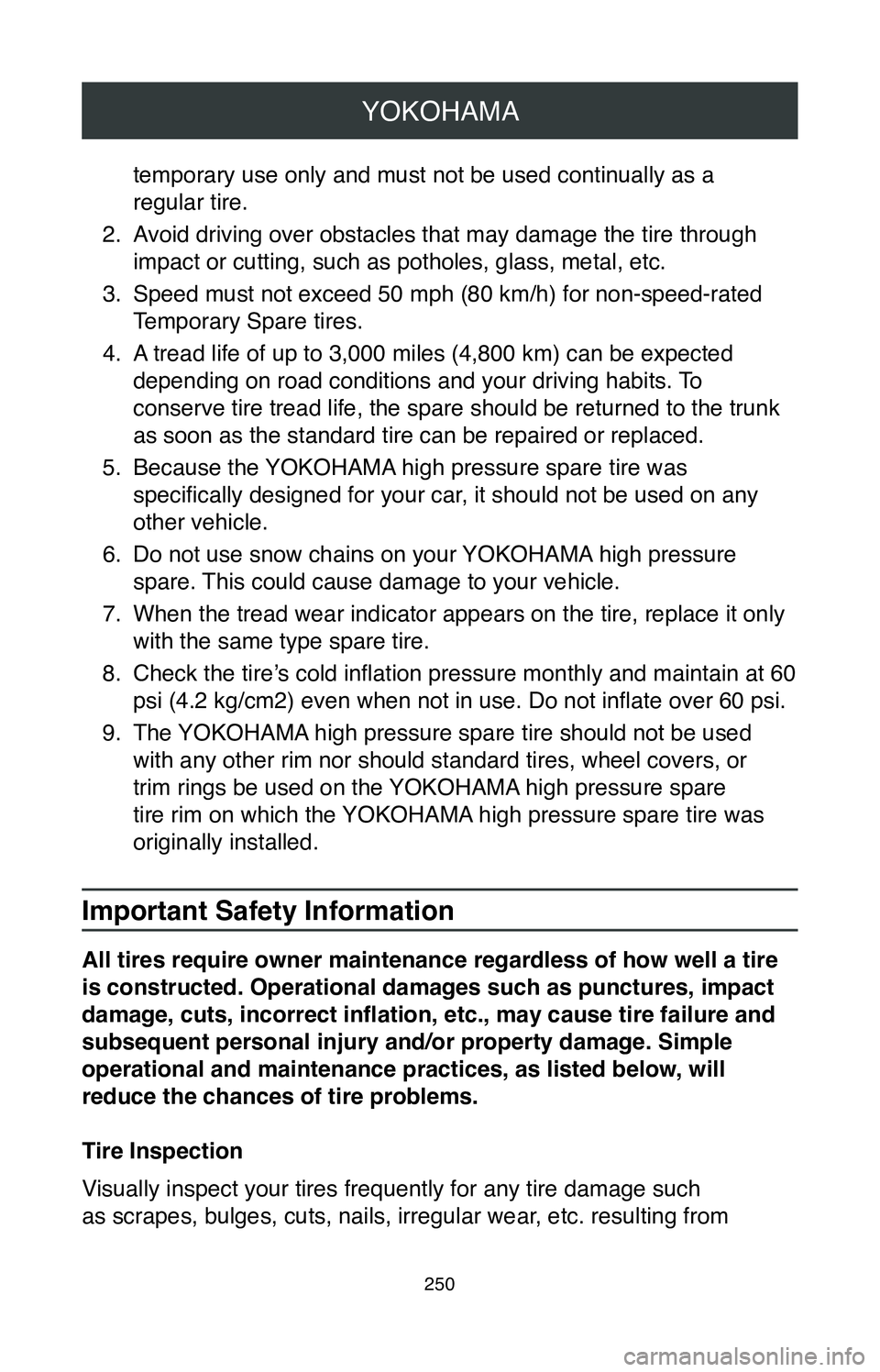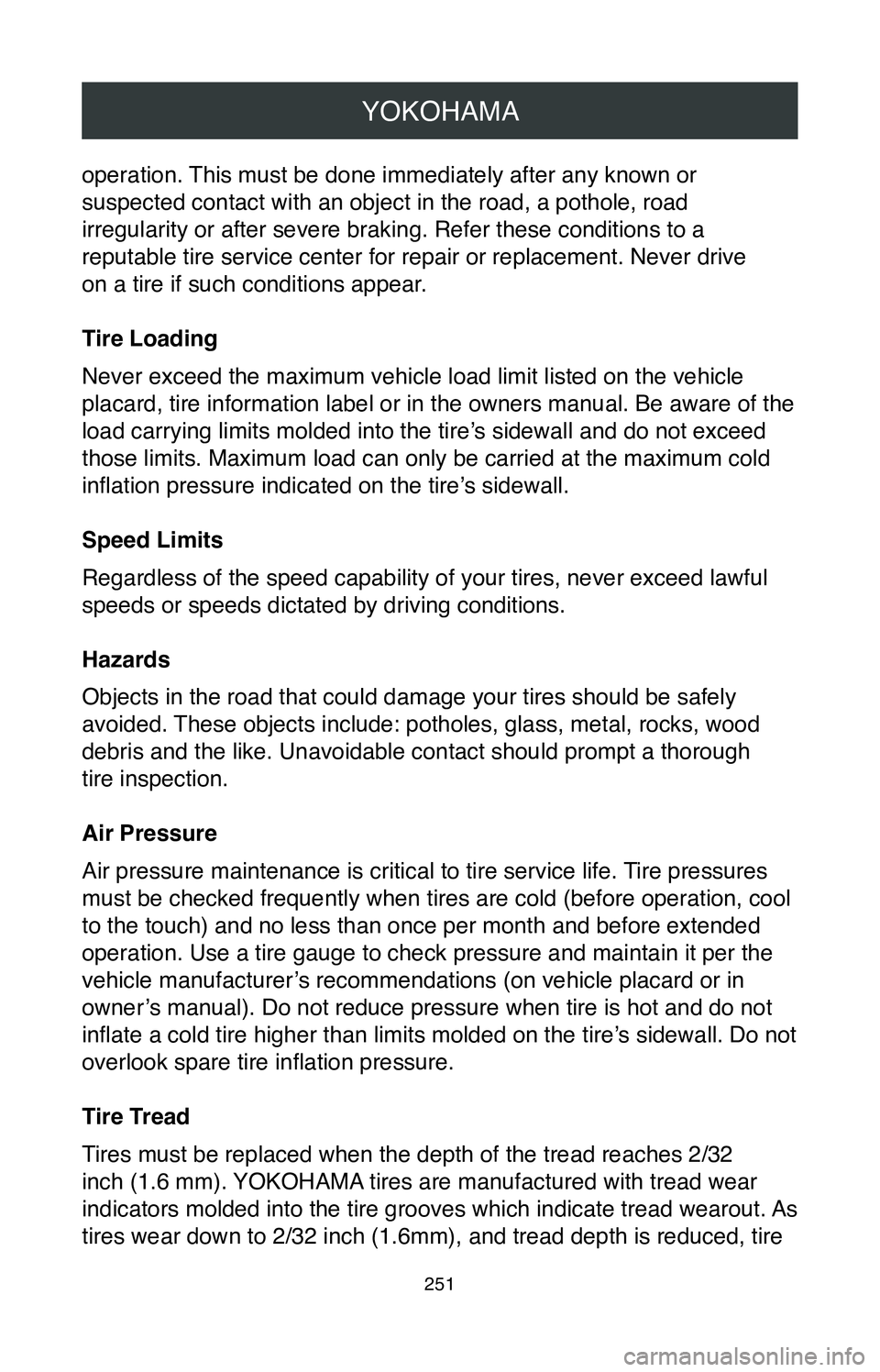tire pressure TOYOTA TACOMA 2020 Warranties & Maintenance Guides (in English)
[x] Cancel search | Manufacturer: TOYOTA, Model Year: 2020, Model line: TACOMA, Model: TOYOTA TACOMA 2020Pages: 260, PDF Size: 8.54 MB
Page 241 of 260

TOYO TIRE
239
at speeds in excess of 65 mph may be required, then the following
adjustments or recommendations should be followed:•
At speeds from 66 mph through 75 mph, cold inflation pressure
must be increased 10 psi above the recommended pressures for
the load being carried.
•
Do not exceed the maximum inflation pressure of the wheel (all
wheels have maximum allowable inflation pressures).
Replacement Tires for Light Trucks – P-Metric vs. LT-Truck
Tire installers should exercise extreme caution when replacing tires on
light trucks.
The maximum load capacity stamped on the sidewall of a P-metric tire
is reduced by a factor of 1.1 when used on a light truck, a sport utilit\
y
vehicle, or a trailer.
Page 251 of 260

YOKOHAMA
249
YOKOHAMA’S Obligations
Replacements qualifying under the warranty will be made by an
authorized YOKOHAMA retail tire dealer and will be handled quickly
Participating dealers in the US may be found at www.yokohamatire.
com/dealer-locator or by calling 1-800-722-9888 and choosing
menu option 1. Participating dealers in Canada can be found at
www.yokohamatire.ca.
Customer’s Obligations
The customer must present the claim tire, together with the vehicle on
which it was used, to an authorized YOKOHAMA retail tire dealer. Tires
replaced on a warranty basis become the property of YOKOHAMA
TIRE CORPORATION.
The customer is required to pay the adjusted price of the new tire
(dealer’s current retail selling price at the time of adjustment less credit
allowance) and taxes. The customer is responsible for any payments
arising out of dealer service such as mounting, balancing, tire rotation\
,
and alignment UNLESS SPECIALLY INCLUDED IN THE APPLICABLE
WARRANTY.
To obtain a free-replacement warranty, the customer must present
proof of vehicle purchase date either by the new vehicle invoice or
license registration.
Legal Rights
This warranty gives you specific legal rights. You may also have other
rights which may vary from state to state.
YOKOHAMA Temporary Spare Tire
High Pressure Spare Operating Instructions
Any tire, no matter how well constructed, may fail due to improper
maintenance or service factors. Tire failure may create a risk of
property damage and serious or fatal injury. For your safety, please
follow the instructions below.
1.
The YOKOHAMA high pressure spare tire is designed for
Page 252 of 260

YOKOHAMA
250
temporary use only and must not be used continually as a
regular tire.
2.
Avoid driving over obstacles that may damage the tire through
impact or cutting, such as potholes, glass, metal, etc.
3.
Speed must not exceed 50 mph (80 km/h) for non-speed-rated
Temporary Spare tires.
4.
A tread life of up to 3,000 miles (4,800 km) can be expected
depending on road conditions and your driving habits. To
conserve tire tread life, the spare should be returned to the trunk
as soon as the standard tire can be repaired or replaced.
5.
Because the YOKOHAMA high pressure spare tire was
specifically designed for your car, it should not be used on any
other vehicle.
6.
Do not use snow chains on your YOKOHAMA high pressure
spare. This could cause damage to your vehicle.
7.
When the tread wear indicator appears on the tire, replace it only
with the same type spare tire.
8.
Check the tire’s cold inflation pressure monthly and maintain at 60
psi (4.2 kg/cm2) even when not in use. Do not inflate over 60 psi.
9.
The YOKOHAMA high pressure spare tire should not be used
with any other rim nor should standard tires, wheel covers, or
trim rings be used on the YOKOHAMA high pressure spare
tire rim on which the YOKOHAMA high pressure spare tire was
originally installed.
Important Safety Information
All tires require owner maintenance regardless of how well a tire
is constructed. Operational damages such as punctures, impact
damage, cuts, incorrect inflation, etc., may cause tire failure and
subsequent personal injury and/or property damage. Simple
operational and maintenance practices, as listed below, will
reduce the chances of tire problems.
Tire Inspection
Visually inspect your tires frequently for any tire damage such
as scrapes, bulges, cuts, nails, irregular wear, etc. resulting from
Page 253 of 260

YOKOHAMA
251
operation. This must be done immediately after any known or
suspected contact with an object in the road, a pothole, road
irregularity or after severe braking. Refer these conditions to a
reputable tire service center for repair or replacement. Never drive
on a tire if such conditions appear.
Tire Loading
Never exceed the maximum vehicle load limit listed on the vehicle
placard, tire information label or in the owners manual. Be aware of the\
load carrying limits molded into the tire’s sidewall and do not exceed
those limits. Maximum load can only be carried at the maximum cold
inflation pressure indicated on the tire’s sidewall.
Speed Limits
Regardless of the speed capability of your tires, never exceed lawful
speeds or speeds dictated by driving conditions.
Hazards
Objects in the road that could damage your tires should be safely
avoided. These objects include: potholes, glass, metal, rocks, wood
debris and the like. Unavoidable contact should prompt a thorough
tire inspection.
Air Pressure
Air pressure maintenance is critical to tire service life. Tire pressures
must be checked frequently when tires are cold (before operation, cool
to the touch) and no less than once per month and before extended
operation. Use a tire gauge to check pressure and maintain it per the
vehicle manufacturer’s recommendations (on vehicle placard or in
owner’s manual). Do not reduce pressure when tire is hot and do not
inflate a cold tire higher than limits molded on the tire’s sidewall. Do not
overlook spare tire inflation pressure.
Tire Tread
Tires must be replaced when the depth of the tread reaches 2/32
inch (1.6 mm). YOKOHAMA tires are manufactured with tread wear
indicators molded into the tire grooves which indicate tread wearout. As
tires wear down to 2/32 inch (1.6mm), and tread depth is reduced, tire